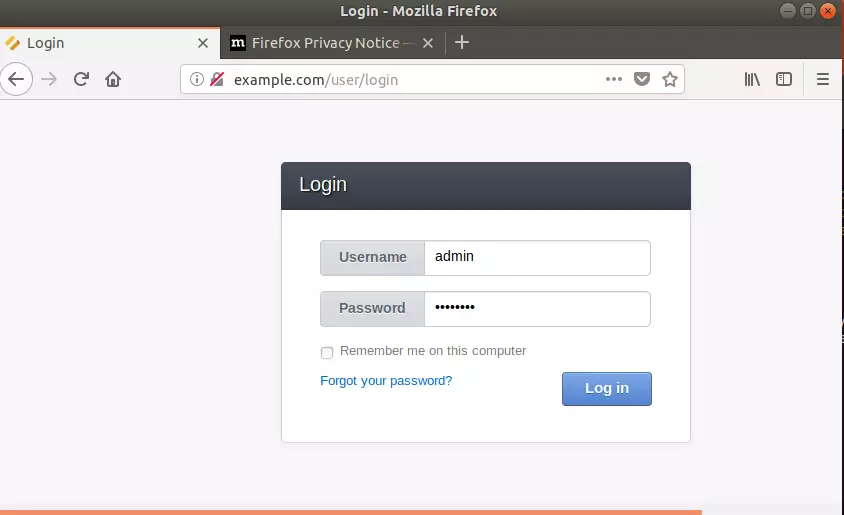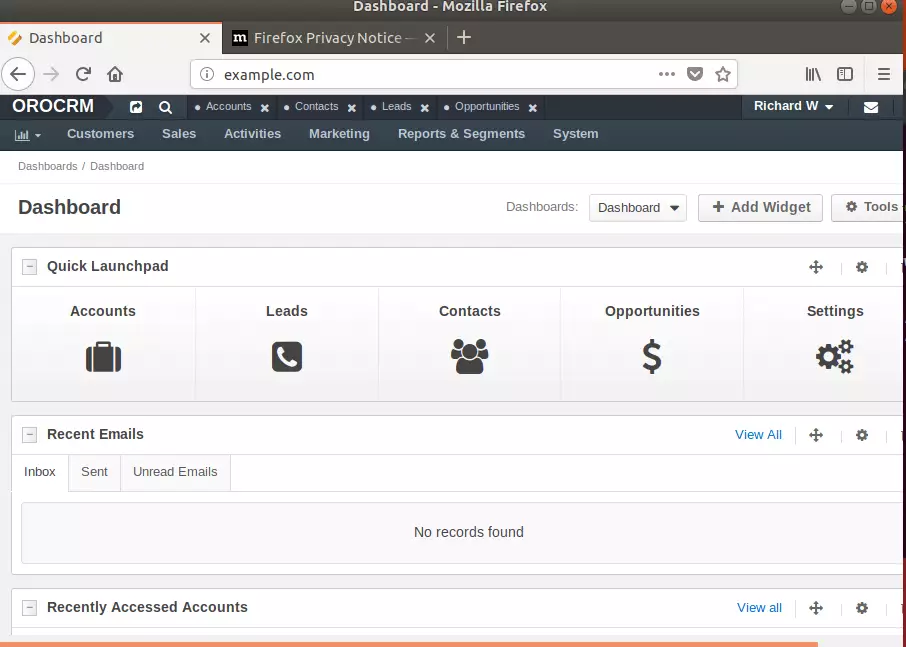This article explains the steps to install OroCRM on Ubuntu Linux with Apache support.
OroCRM is designed to allow enterprises and business owners to collaborate and automate engaging experiences with customers throughout the entire process. OroCRM comes in Community Edition (CE) and Enterprise Edition (EE).
Installing OroCRM with Apache on Ubuntu Linux allows enterprises and business owners to collaborate and automate engaging customer experiences throughout the entire process. OroCRM is an open-source CRM software written in PHP and offers features that help you run your business and collaborate with your customers.
Installing OroCRM on Ubuntu Linux with Apache support enables you to take advantage of Apache’s powerful web server capabilities, as well as the security and stability of Ubuntu Linux.
Additionally, Apache support provides a robust and reliable platform for hosting OroCRM, ensuring that your customer relationship management solution is always available to you and your team.
Install OroCRM on Ubuntu Linux with Apache support
As described above, OroCRM is designed to allow enterprises and business owners to collaborate and automate engaging customer experiences throughout the process.
Below is how to install it on Ubuntu Linux with Apache support.
Install Apache
Apache2 HTTP Server is the most popular web server. Install it since OroCRM needs it.
To install Apache2 HTTP on the Ubuntu server, run the commands below.
sudo apt update sudo apt install apache2
After installing Apache2, the commands below can stop, start, and enable the Apache2 service to always start up with the server boots.
sudo systemctl stop apache2.service sudo systemctl start apache2.service sudo systemctl enable apache2.service
To test the Apache2 setup, open your browser and browse to the server hostname or IP address. You should see the Apache2 default test page, as shown below.
When you see that, Apache2 will work as expected.
http://localhost

Install MariaDB
MariaDB database server is a great place to start when looking at open-source database servers for Magento. To install MariaDB, run the commands below.
sudo apt-get install mariadb-server mariadb-client
After installing MariaDB, the commands below can stop, start, and enable the service to start when the server boots.
Run these on Ubuntu 16.04 LTS
sudo systemctl stop mysql.service sudo systemctl start mysql.service sudo systemctl enable mysql.service
Run these on Ubuntu 17.10 and 18.04 LTS
sudo systemctl stop mariadb.service sudo systemctl start mariadb.service sudo systemctl enable mariadb.service
After that, run the commands below to secure the MariaDB server by creating a root password and disallowing remote root access.
sudo mysql_secure_installation
When prompted, answer the questions below by following the guide.
- Enter current password for root (enter for none): Just press the Enter
- Set root password? [Y/n]: Y
- New password: Enter password
- Re-enter new password: Repeat password
- Remove anonymous users? [Y/n]: Y
- Disallow root login remotely? [Y/n]: Y
- Remove test database and access to it? [Y/n]: Y
- Reload privilege tables now? [Y/n]: Y
Type the commands below to log into the MariaDB server to test if MariaDB is installed.
sudo mysql -u root -p
Then, type the password you created above to sign on. If successful, you should see a MariaDB welcome message.

Install PHP 7.1 and Related Modules
PHP 7.2 isn’t available on Ubuntu’s default repositories. To install it, you must get it from third-party repositories.
Run the commands below to add the below-party repository to upgrade to PHP 7.2
sudo apt-get install software-properties-common sudo add-apt-repository ppa:ondrej/php
Then update and upgrade to PHP 7.1
sudo apt update
Next, run the commands below to install PHP 7.2 and related modules.
sudo apt install php7.1 libapache2-mod-php7.1 php7.1-common php7.1-curl php7.1-intl php7.1-mbstring php7.1-mcrypt php7.1-json php7.1-xmlrpc php7.1-soap php7.1-mysql php7.1-gd php7.1-xml php7.1-cli php7.1-zip
After installing PHP 7.2, run the commands below to open the PHP default config file for Apache2.
sudo nano /etc/php/7.1/apache2/php.ini
Then, save the changes on the following lines below in the file. The value below is an ideal setting to apply in your environment.
file_uploads = On allow_url_fopen = On memory_limit = 512M upload_max_filesize = 100M max_execution_time = 360 date.timezone = America/Chicago
After making the change above, please save the file and close it.
After installing PHP and related modules, you must restart Apache2 to reload PHP configurations.
To restart Apache2, run the commands below
sudo systemctl restart apache2.service
To test PHP 7.2 settings with Apache2, create a phpinfo.php file in the Apache2 root directory by running the commands below
sudo nano /var/www/html/phpinfo.php
Then, type the content below and save the file.
<?php phpinfo( ); ?>
Save the file. Then browse to your server hostname followed by /phpinfo.php
http://localhost/phpinfo.php
You should see the PHP default test page.

Create OroCRM Database
Now that you’ve installed all the required packages continue below to start configuring the servers.
First, run the commands below to create the OroCRM database.
Run the commands below to log on to the database server. When prompted for a password, type the root password you created above.
sudo mysql -u root -p
Then, create a database called orocrm
CREATE DATABASE orocrm;
Create a database user called orocrmuser with a new password
CREATE USER 'orocrmuser'@'localhost' IDENTIFIED BY 'new_password_here';
Then, grant the user full access to the database.
GRANT ALL ON orocrm.* TO 'orocrmuser'@'localhost' IDENTIFIED BY 'user_password_here' WITH GRANT OPTION;
Finally, save your changes and exit.
FLUSH PRIVILEGES; EXIT;
Install Node.js and Composer
OroCRM requires Node.js and Composer to be installed on the system. You’ll need these tools to download and install OroCRM.
To install these packages, run the commands below.
curl -sS https://getcomposer.org/installer | sudo php -- --install-dir=/usr/local/bin --filename=composer
The commands above will download Composer from its maintainer page and install it into the /usr/local/bin directory. This is a local-global directory for application executables.
If you don’t have curl installed, run the commands below to install it with git. Then, rerun the commands above.
sudo apt install curl git
Next, run the commands below to install Node.js
sudo curl --silent --location https://deb.nodesource.com/setup_8.x | sudo bash - sudo apt install nodejs
Download OroCRM Latest Release
Next, visit the OroCRM site and download the latest version.
After downloading, run the commands below to extract the download file into the Apache2 root directory.
cd /var/www/html/ sudo git clone -b 2.4 https://github.com/oroinc/crm-application.git orocrm cd orocrm sudo composer install --prefer-dist --no-dev
When you run the commands above, you’ll be asked for the database connection info you created above.
Some parameters are missing. Please provide them. database_driver (pdo_mysql): database_host (127.0.0.1): database_port (null): database_name (oro_crm): orocrm database_user (root): orocrmuser database_password (null): user_password_here mailer_transport (smtp): mailer_host (127.0.0.1):
Next, run the commands below to complete the installation
sudo php app/console oro:install --env=prod
You’ll be prompted to create an admin account to manage the backend during the setup.
Administration setup.
Application URL (http://localhost):
Organization name (OroCRM):
Username (admin):
Email: admin@example.com
First name: Richard
Last name: W
Password:
Load sample data (y/n): y
Then, run the commands below to set the correct permissions for OroCRM to function.
sudo chown -R www-data:www-data /var/www/html/orocrm/ sudo chmod -R 755 /var/www/html/orocrm/
Configure Apache2
Finally, configure the Apahce2 site configuration file for OroCRM. This file will control how users access OroCRM content. Run the commands below to create a new configuration file called orocrm.conf.
sudo nano /etc/apache2/sites-available/orocrm.conf
Then copy and paste the content below into the file and save it. Replace the highlighted line with your domain name and directory root location.
<VirtualHost *:80>
ServerAdmin admin@example.com
DocumentRoot /var/www/html/orocrm/web
ServerName example.com
ServerAlias www.example.com
<Directory /var/www/html/orocrm/web>
Options +FollowSymlinks
AllowOverride All
Require all granted
</Directory>
ErrorLog ${APACHE_LOG_DIR}/error.log
CustomLog ${APACHE_LOG_DIR}/access.log combined
</VirtualHost>
Save the file and exit.
Enable the OroCRM
After configuring the VirtualHost above, please enable it by running the commands below.
sudo a2ensite orocrm.conf sudo a2enmod rewrite
Restart Apache2 by running the commands below to load all the settings above.
sudo systemctl restart apache2.service
Then open your browser and browse to the server domain name, followed by install. Finally, you should see the OroCRM setup wizard complete. Please follow the wizard carefully.
http://example.com
Then, type the admin username and password you created above to sign in.

Enjoy!


Leave a Reply Cancel reply